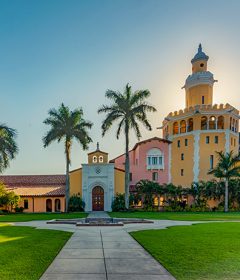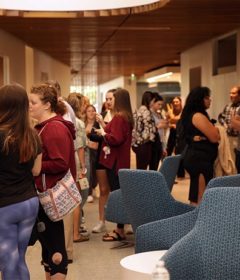A Summer in Mexico
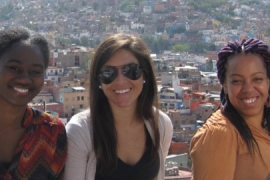
This article appears in the new Summer Issue of Stetson University Magazine. To read the entire magazine, click here.
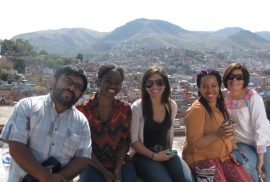
During the 10-day trip, she and two other Stetson students, plus a professor, visited Mexico City, the bustling capital city with 21 million residents in and surrounding it. They also saw the country’s ancient pyramids, collected data for their research projects and spent time with young children at an after-school program/orphanage in the rural city of Guanajuato, playing games, helping with homework and singing songs before spending several nights with a host family.
“In my mind, before I went, I pictured dirt roads. And people asked me if I was going to Cancun,” Guyton said, referring to the popular Mexican vacation spot. “I was nervous and excited. I’d heard all the bad things about drug cartels and violence. But I didn’t see one bad thing. The people were so friendly. I found a country that was very rich culturally. They are just like us. People.”
In turn, Guyton, newly graduated as an education major, plans to carry forward lessons learned as she teaches others.
“I think I have a better worldview on how different cultures work, and how difficult it is for people from other countries living here [in the United States] to adapt. I empathize with the challenges that foreigners face in America,” added Guyton, who was active in Stetson’s chapter of The Alexander Hamilton Society, a nonpartisan organization dedicated to promoting constructive debate on basic principles and contemporary issues in foreign, economic and national security policy.
Her MFE research project analyzed the experiences Mexican children have in American elementary schools and offered innovative suggestions for improving their education in the United States.
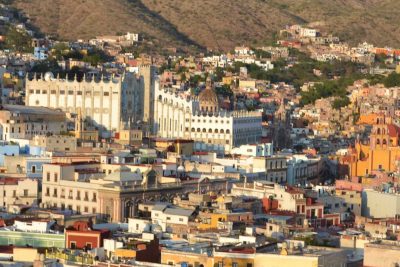
The MFE began at Stetson in 1995, fully funded by alumnus Mark Hollis ’56, a former trustee. The program covers the expenses of three or four students each summer on professor-led trips to South America, Central America, Mexico and the Caribbean. Over the years, MFE students, selected after a competitive interview and evaluation process, have traveled to Argentina, Belize, Brazil, Ecuador, Guatemala, Peru, Puerto Rico and Uruguay.
Before visiting a country, the students spend the spring semester in the classroom, preparing for the trip by learning the history, politics and culture of the nation, as well as submitting a research proposal. During the trip, the students collect data for those projects, culminating with a fall-semester, post-travel evaluation course and presentation of their research at Stetson.
This summer, students in the program visited Colombia.
Nicole Mottier, Ph.D., an assistant professor in the Department of History, led the summer 2016 trip to Mexico.
“We choose as many students as we can afford. We prepare them intellectually for the country,” said Mottier, who teaches courses on colonial and modern Latin American histories and also is developing courses on the histories of global capitalism and on the history of drug cartels in the Americas. “I taught them about the history, economics and cultures of Mexico. I chose some students who had never been out of the country before. In the Mentored Field Experience, we try integrating their in-country experience with the foundation they received in the first part of the course. Being in another country broadens their worldview, and working on their research hones their analytical skills.”
Mottier also is publishing on the political and social histories of peasant loans in 20th-century Mexico and is beginning a monograph that analyzes the history of organized crime in Mexico over 100 years.
LAND OF LEARNING
Maybe nothing was more significant in expanding the MFE students’ worldview than the group’s visit to the ancient pyramids of Teotihuacan, the City of the Gods, founded in the final two centuries B.C. The name comes from the Aztecs, who visited the city centuries after it was abandoned. The larger of the pyramids predates all of the Mayan structures by several hundred years. It mimics the shape of the surrounding mountains and contains several tombs.
Besides learning about Mexican history by visiting the pyramids, the students learned about Mexico’s informal economy by riding boats through the floating gardens of Xochimilco while being entertained by a mariachi band. They tasted Mexico’s sophisticated cuisine by eating food prepared in the culinary styles of the ancient Aztecs and Mayans. And they saw the importance of Catholicism in Mexico by visiting historic churches, including the famous Basilica of Our Lady of Guadalupe. The old Roman Catholic church and a more modern national shrine stand near a hill where in 1531 the vision of the Virgin Mary is believed to have appeared before Saint Juan Diego Cuauhtlatoatzin, an Aztec convert to Catholicism.
According to the story told by locals, Saint Juan Diego was walking between his village and Mexico City when Our Lady of Guadalupe appeared and told him to build a church at that site. Today, it is one of the most important pilgrimage sites for Catholics, visited by millions of people annually
The land, as well as the residents, spoke to the students.
“It was a fun way to turn abstract concepts into concrete knowledge,” Mottier continued her explanation. “It opened their eyes to understand Mexico in a more nuanced way. I couldn’t have asked for better students. They threw themselves into their research and the experience.”
Christine Chase, who graduated in May with a finance degree and a minor in Spanish, had applied for the MFE her first couple of years at Stetson before being selected. She was a member of the Stetson Honors Program, Phi Eta Sigma Honor Society and Beta Gamma Sigma Honor Society and a former president of Alpha Kappa Psi. The Mexico trip was her first time outside the United States.
Her MFE research project analyzed lucha libre (Mexican wrestling) from historical and contemporary perspectives and suggested new ways of understanding lucha libre both culturally and politically.
“My expectations were that I was going to broaden my horizons. We live in a bubble here. I wanted to get a glimpse at how other people live and what they value. The best way to get to know how to use a language is to be immersed in it. Being with the people is the best,” said Chase, adding she was at ease in Mexico, even in Mexico City, the world’s third-largest city.
Her highlight of the trip was climbing to the top of one of the pyramids, where she could look out and reflect within, both about her own life and those who came before her.
Broadened horizons, indeed, far from the classroom.
“The trip was eye-opening for me, especially seeing the poverty,” Chase concluded. “I realize what a blessed life I have in this country. But I took back with me a little piece of how others live.”
-By Ray Weiss


